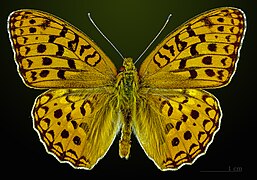Fiery mother-of-pearl butterfly
| Fiery mother-of-pearl butterfly | ||||||||||||
|---|---|---|---|---|---|---|---|---|---|---|---|---|

Fiery mother-of-pearl butterfly ( Fabriciana adippe ), ♀ |
||||||||||||
| Systematics | ||||||||||||
|
||||||||||||
| Scientific name | ||||||||||||
| Fabriciana adippe | ||||||||||||
| ( Denis & Schiffermüller , 1775) |
The fiery mother-of-pearl butterfly ( Fabriciana adippe , syn .: Argynnis adippe ) is a butterfly (day butterfly ) from the noble butterfly family (Nymphalidae). It is also referred to in German-language literature as the Adippe mother-of-pearl butterfly, fiery mother-of-pearl butterfly, fiery forest hill country mother-of-pearl butterfly, march violet butterfly, march violet mother-of-pearl butterfly and dog violet mother-of-pearl butterfly.
features
The moths reach a wingspan of 40 to 45 millimeters. As with many mother-of-pearl butterflies, the upper sides of the wings are colored orange and have a black pattern. The males wear scented scales on the veins Cu1 and Cu2 on the upper side of the forewings and a hair comb on the radial artery on the hind wings. On the orange underside of the hind wings, in addition to some finely black-edged mother-of-pearl spots, small white spots with a brown border are characteristic in the post-disc region . These are missing from the similar great mother-of-pearl butterfly ( Speyeria aglaja ). On the outer edge there is a row of larger mother-of-pearl spots. These spots are slightly tapered on the inward-facing side and have a brownish edge.
The caterpillars have a grayish base color. On the back there is a wide black ribbon that is interrupted between each segment. This distinguishes the animals from the similar caterpillars of the Middle Mother of Pearl ( Fabriciana niobe ). Inside the bandage there is a fine, also interrupted, light line in the middle of the back. The head capsule, like the numerous branched thorns on the body, is colored brown.
Subspecies and forms
Fabriciana adippe auresiana (Fruhstorfer, 1908)
- The green pollination on the underside of the hind wings is darker and the basal mother-of-pearl spots are smaller or absent. In the males, the scented flakes of the front wings and the hair crest of the rear wing are smaller. One generation is formed per year that flies from June to early August. The subspecies prefers open, dry places with shrub growth, flower-rich slopes, open forests and rocky gorges with little vegetation. It occurs in North Africa and Algeria .
Fabriciana adippe f. cleodexa (Ochsenheimer, 1816)
- The moths have no silver spots on the underside except in the cores of the brown spots of the post-fiscal region. The relationship between the two forms f. cleodexa and f. adippe is very different from region to region. In northern and northeastern Europe ( England , Belgium , the Netherlands , Denmark , Fennoscandinavia ) f dominates . adippe very strong and f. cleodexa is very rare. In central France , Germany , Austria and northern Switzerland , f. cleodexa is found somewhat more frequently and then predominates in southern Switzerland , northern Italy , Slovenia and the Apennines . In Sicily then f. adippe to be completely absent. Although f. cleodexa is common in the Pyrenees , the shape without silver spots is again rare in Spain . From Hungary to the southeast across the Balkan Peninsula , f. cleodexa more and more often up to Greece f. adippe no longer occurs.
Similar species
- Middle mother-of-pearl butterfly ( Fabriciana niobe )
- Great mother-of-pearl butterfly ( Speyeria aglaja )
Synonyms
- Argynnis chlorodippe Herrich-Schäffer, 1851
- Argynnis cleodoxa Ochsenheimer, 1816
- Papilio cydippe Linnaeus, 1761 (invalid name)
Occurrence
The animals come from northwest Africa over almost all of Europe over temperate Asia , east to Japan . They are absent north of the Arctic Circle , on much of the British Isles, and on most of the Mediterranean islands. They are found in dry, grassy and bushy areas and on the edges and clearings of loose forests. In contrast to the great mother-of-pearl butterfly, bushes do not bother them.
Way of life
The adults suck nectar from the daisy family and thistles and can be found in groups, especially at the edge of the forest.
Flight and caterpillar times
The moths fly in one generation from mid-June to August. The caterpillars can be found from August and after wintering until June.
Food of the caterpillars
The caterpillars feed on violets ( viola ).
development
The females lay their cone-shaped, longitudinally ribbed eggs on the leaves of the forage plants. The caterpillars already hibernate in the egg to hatch, but do not hatch until spring. Pupation takes place in a clumsy falling pupa on strong stems near the ground. The pupa is brown and has several silvery metal spots and is much smoother and has less well-developed prongs than that of the imperial cloak ( Argynnis paphia ).
swell
Individual evidence
- ^ Robert S. De Moya et al .: Interrelationships and diversification of Argynnis (Fabricius) and Speyeria (Scudder) butterflies . In: Systematic Entomology . tape 42 , 2017, p. 635-649 , doi : 10.1111 / syen.12236 .
- ↑ a b c d Tom Tolman, Richard Lewington: Die Tagfalter Europäische und Nordwestafrikas , S. 152f, Franckh-Kosmos Verlags-GmbH & Co, Stuttgart 1998, ISBN 3-440-07573-7
- ↑ a b c d e Hans-Josef Weidemann: Tagfalter: watch, determine , p. 426f, Naturbuch-Verlag Augsburg 1995, ISBN 3-894-40115-X
- ^ Lionel G. Higgins and Norman D. Rilley, Die Tagfalter Europas und Nordwestafrikas (A Field Guide to the Butterflies of Britain and Europe) , Verlag Paul Parey 1971, ISBN 3-490-02418-4
- ↑ a b c Argynnis (Fabriciana) adippe (Denis & Schiffermüller 1775). Fauna Europaea, Version 1.3, April 19, 2007 , accessed on July 18, 2007 .
- ↑ Manfred Koch : We identify butterflies. Volume 1: Butterfly. 4th enlarged edition. Neumann, Radebeul / Berlin 1966, DNB 457244224 , p. 98f.
Web links
- Lepiforum e. V. Taxonomy and Photos
- www.schmetterling-raupe.de
- Moths and Butterflies of Europe and North Africa (English)




